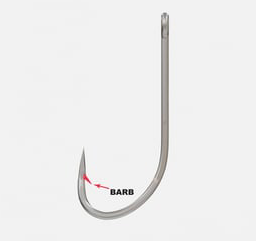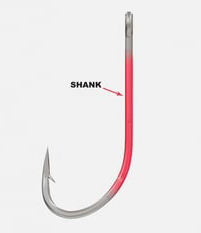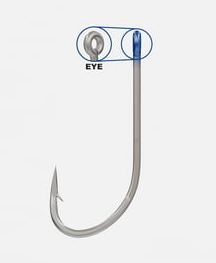Welcome to NT Swivel, Ten Mouth & Eagle Claw hooks NZ
Expain the Anatomy of a fish hook
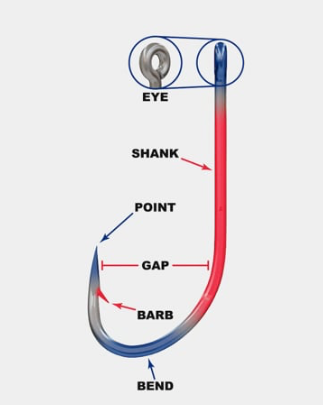
The anatomy of a fish hook is an essential foundation to understand for any angler, as the design and components of a hook directly impact fishing success. Fish hooks come in various shapes and sizes, but most basic hooks share several key parts, each with a specific function that contributes to hooking and securing a fish effectively.
Point
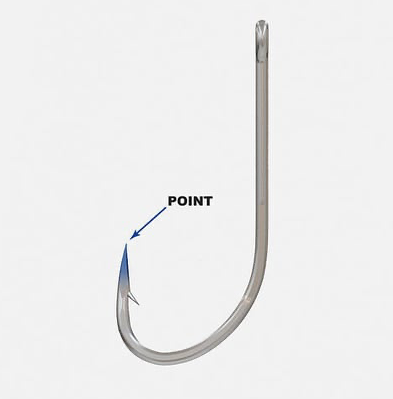
The point is the sharp end of the hook designed to penetrate the fish’s mouth during a strike. Modern fish hooks often feature chemically sharpened points or specialized designs like needle points or trokar points to increase penetration efficiency with less effort. A sharp, well-crafted point reduces the number of missed strikes and improves hook-up rates, making it arguably the most critical part of the hook.
The Forged Point from Eagle Claw is known for its durability and strength, making it a clear choice among anglers. With a long history of reliability, this hook point is trusted by generations of anglers. It is an affordable option that offers excellent performance, making it a great choice for anglers on a budget.
The Needle Point from Lazer Sharp Hooks is an extremely sharp hook point that is easy to sharpen. Many anglers prefer this point for its sharpness, and it is ideal for a variety of fishing applications. Whether you're a seasoned angler or just starting out, the Needle Point is a great choice for all your angling needs.
Barb
Located just behind the point, the barb is a small backward-facing projection. The barb’s purpose is to prevent the hook from slipping out once it has penetrated the fish’s mouth. While barbless hooks are popular for catch-and-release fishing due to their easier removal and less injury to the fish, barbed hooks remain common because they provide greater security during the fight, preventing the fish from shaking free.
Standard Barb Hooks: The standard barb is the most widely used type of barb and is featured on 95% of all fishing hooks. Despite its simple design, the standard barb is highly efficient in keeping fish securely attached to the line.
Barbless Hooks: These are fishing hooks without a traditional barb, making them a popular choice for catch-and-release anglers. Removing barbless hooks is much easier and quicker, making them suitable for fishing with children. Additionally, some fisheries in the United States and Canada require barbless hooks.
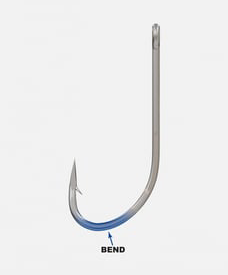
Bend
The bend is the curved section of the hook that forms its familiar shape. The bend’s size and curvature affect how the hook holds bait and how it positions in the fish's mouth. For example, wide-gap bends offer extra room for bait like soft plastics or chunk bait, while narrow bends excel with smaller, live baits. The bend also dictates the hook’s overall style, such as circle hooks, octopus hooks, or J-hooks.
The Pro-V bend is easily recognizable thanks to its unique V-shape at the bend. This bend offers several benefits to anglers, but perhaps the most important is immediately directing fish to the deepest part of the bend and keeping them locked in place. When fish are hooked with a Pro-V bend, it is difficult to remove them, making pliers an essential tool for any angler using this style of hook.
The J hook is the most classic and well-known hook bend and resembles the letter "J." The design of the J hook dates back thousands of years and has remained largely unchanged throughout history. The simplicity of its design has made it a favorite of anglers for generations. J hooks come in a wide range of sizes, from small freshwater hooks to massive hooks designed for catching sharks, with many variations that have been developed to suit different fishing applications.
Round bend hooks are similar to J hooks, but the bend on a round hook is noticeably circular. This design allows for a large bite area, making the hook-up ratio for most round bend hooks excellent. The traditional offset worm hook is the most popular round bend style hook, but you can also find round bend treble hooks and straight shank round bends. Round bend hooks have become increasingly popular among anglers due to their versatility and high hook-up ratio.
Circle hooks are defined by their circular bend that extends up into the throat of the hook and a point that points back 90 degrees toward the shank. The circle shape of the bend sets this hook apart from others and makes it a favorite among conservation-minded anglers. Circle hooks have a reputation for consistently hooking fish in the corner of the mouth, making it easier and quicker to release them unharmed. The evolution of circle hooks has been driven by a need for a more humane way of fishing and has become widely used and loved around the world.
The bend on wide gap hooks is more gradual, allowing for more area between the hook point and shank. When using larger bait, whether live or artificial, there needs to be room for the bait to collapse out of the way to get a solid hookset. By widening the gap on hooks, anglers are able to provide more room for bait to collapse, resulting in a higher hook-up ratio when using bulkier bait. Wide gap hook designs have become a go-to option for many fishing scenarios due to their success.
Shank
The shank is the straight section of the hook between the bend and the eye. The shank length varies by hook type and influences bait presentation and the leverage anglers have when setting the hook. Longer shanks can make it easier to remove hooks from fish mouths and can help with certain rig styles, while shorter shanks are more compact and suited for tight or fast strikes.
Forging a shank is a process that improves the strength of fishing hooks, making them more resistant to opening or bending out. When a hook is designated to have a forged shank, the forged area usually encompasses the entire bend moving up the shank but not all the way up to the eye or down to the point.
Eye
The eye is the loop at the end of the shank where the fishing line or leader is tied. Eyes come in various styles, such as ringed, straight, or offset. Ringed eyes are common and allow for easy snelling (attaching the line with a snell knot) to keep the hook aligned with the bait and line. Offset eyes help with hook positioning on some rig types.

Additional Features
Some fish hooks have additional features to optimize performance:
- Wire gauge: This refers to the thickness of the hook wire, which influences hook strength and flexibility. Heavy-gauge hooks are stronger and used for bigger fish, while light-gauge hooks work better for finesse fishing with smaller species or delicate baits.
- Finish: Hooks often have protective coatings like black nickel, bronze, or platinum black to prevent rust, reduce visibility in water, or increase durability.
- Specialized points: Hooks may include extra needle points (like trebles), ringed barbs, or chemically treated surfaces for smoother penetration.
Summary
In summary, a fish hook’s anatomy—point, barb, bend, shank, and eye—is finely tuned for reliable hooksets and fish retention. The choice of hook type and its specific features depend on the target species, fishing style, and bait. Understanding the roles of each part helps anglers select the best hook for their fishing needs and increases their chances of a successful and ethical catch.
Display prices in:NZD
